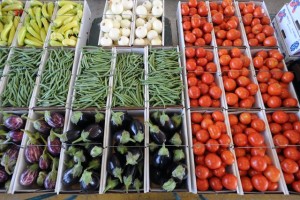Guest author, Kendal Shaffer, a Masters of Food & Nutrition graduate student at Bowling Green State University shares variables to answer the question, “could local produce be more nutritious?” Buying local produce helps support your community, economy, local farmers and possibly even your health! While there are many factors that determine the nutritional content(PDF) of produce; soil composition, produce variety, growing methods, ripeness when harvested, processing methods, and distance from farm to plate local foods may have a leg up on the competition. Let’s take a closer look at each of these variables to see why local foods may be a step above the rest.
• Companies have perfected production of fruits and vegetables by selecting varieties that can grow in crowded conditions, be uniform in shape and color, produce larger yields and transport easily. Some of these practices may not take the effects on nutrition into consideration. Local farmers are more likely to grow for taste and nutritional value over ship-ability. This can explain the unique colors and shapes often seen at local markets. Embrace this visual and nutritional diversity!
• Growing methods can greatly affect nutritional content! Plants draw their nutrients from the soil so fertilizer types and soil practices such as the use of compost and manure can have a big impact. At a local market you can generally discuss growing practices, use of pesticides and sprays, and soil treatments directly with growers. Take advantage of this unique opportunity!
• While nutrients come from the soil, the roots and stem of a plant are what deliver it to the produce. Items that have a far distance to travel are often picked prematurely. The more mature the food is, the sooner it will rot, and non-local foods may have a long drive before they reach supermarket shelves. Items picked before peak ripeness may have less nutritional content than their plant ripened counter parts. This is especially true for vitamin C containing produce such as peppers, tomatoes, apricots, and peaches. Other vitamins such as A, E and some B vitamins begin to deteriorate after harvesting.
• Processing can refer to a wide range of practices from cooking and canning to simple protective coatings. Various methods can affect enzyme activity and therefore nutritional content. While preservatives are sometimes necessary for non-local items, you’re more likely to receive whole foods with minimal processing practices when purchasing local. Additionally, local foods are more likely to be handled by less people which decreases the chance for damage and for contamination.
• When food is transported long distances, bruising and physical damage can often cause nutritional losses. Not to mention, the longer it takes for the food to move from plant to plate, the more loss it experiences as well. Foods from other countries or other parts of your own country, have spent a lot of time in trucks and distribution centers before being placed on a store shelf. Local foods tend to see less truck time, less temperature fluctuation, and faster farm to plate turnaround. Click here for more information on food transportation(PDF), food distribution and food policy.
For more reasons to shop local, watch this informative video on farmers’ markets. Even though school has started, there are still many produce options available at local farmers markets this time of year.


